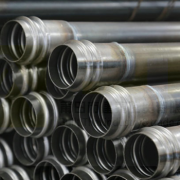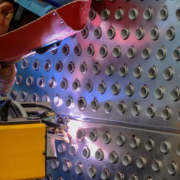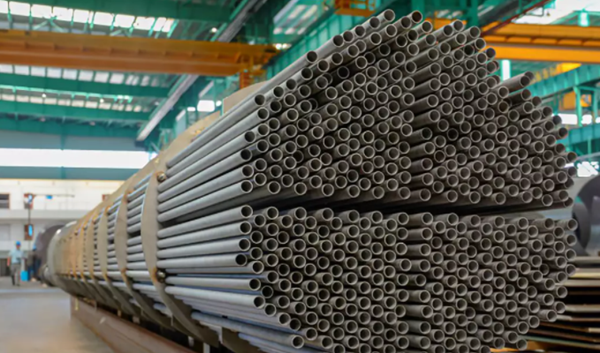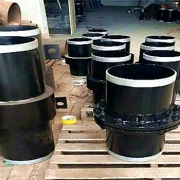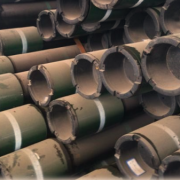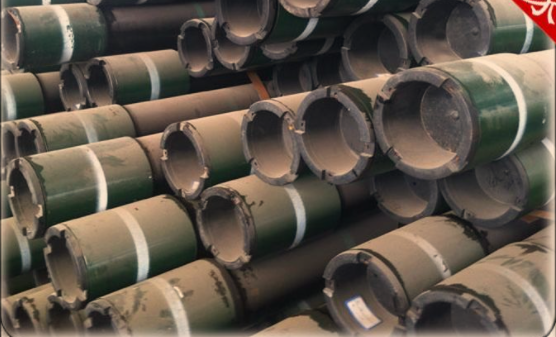The weldability of J55 oil casing
The oil casing is composed of a collar and pipe body. A single pipe body is connected with the collar thread and transported to the oil field site with end to end connection to facilitate transportation and use after reaching the required length. In order to strengthen the strength and anti-loosening control of the threaded connection, it is necessary to weld the coupling with the pipe body after the threaded connection, so it is very important to analyze the welding performance and formulate a reasonable welding process. API 5A J55 is one of the most commonly used casing materials, and we analyzed its weldability in terms of its carbon equivalent.
API 5CT J55 Chemical Composition
| Grade | C | Si | Mn | P | S | Cr | Ni | Cu | Mo |
| API 5CT J55 | 0.34-0.39 | 0.20-0.35 | 1.25-1.50 | 0.020 | 0.015 | 0.15 | 0.20 | 0.20 | / |
According to the carbon equivalent formula of the International Institute of Welding:
CE=C+Mn/6+(Cr+Mo+V)/5+(Ni+Cu)/15
CE=0.69>0.4
Its carbon equivalent is more than 0.4 and its weldability is poor. In order to obtain qualified welding quality, high preheating temperature and strict technological measures are needed.
Its weldability was analyzed according to the influence of J55 alloy element content on microstructure and properties:
- J55 casing tube has a high carbon content, that’s 0.34%~0.39%, which makes the supercooled austenite transition curve of steel move to the right and increase; The addition of Cr, Mn, Ni, Cu and other alloy elements makes the transition curve of supercooled austenite shift to the right, which enhances the stability of the supercooled austenite, and increases the MS point (the beginning point of martensite formation). All these effects increase the quenching tendency of J55, and welding cracks have appeared.
- J55 has a large tendency to cold crack, mainly quenching and embrittlement crack. Due to its high strength, high maximum hardness value of welding heat affected zone and rapid cooling, martensite is easily generated. When welding, try to choose large line energy and welding current, should not excessively reduce the welding speed. In order to reduce the cooling rate, extend the cooling time of the welded joint from 800 ℃ to 500℃, improve the microstructure of the weld metal and the heat-affected zone, and reduce the maximum hardness of the heat-affected zone, preheating before welding and tempering after welding is required.
- The hot crack tendency of J55 is not high because its thermal conductivity is not easy to generate low fusion eutectic; The reheat crack tendency is not large, because it does not contain strong carbide. The welding wire ER55-G matched with its strength is selected. The welding wire has excellent welding process performance, high Ni content, strong cold crack resistance, and excellent comprehensive mechanical properties of the deposited metal.
- Due to the large heat input required for J55 welding, the strength value of base material and welding material is large, and the internal stress during welding is extremely large. During welding, it is necessary to hammer the weld while welding. After welding, heat treatment is carried out to eliminate the internal stress and avoid the post-welding cracking caused by excessive stress. Post-weld heat treatment can also improve the welding microstructure properties.
Welding process of J55
Welding method 1: 80% Ar+20%CO2 gas shielded welding. Welding material: welding wire ER55-G, diameter Φ3.2mm. Welding parameters: current 250~320A, voltage 26 ~30V; Welding speed 35~50cm/min;
The preheating temperature is 100℃, and the interlayer temperature is not lower than the preheating temperature, but it is not allowed to be higher than the preheating temperature of 30℃.
Post-welding treatment: air cooling without any heat treatment.
Results: The tensile test was qualified. The impact values of the three samples in the heat-affected zone are 26,47,23, unqualified. The four side bending samples have 3.75mm crack, 4mm crack, 1.38mm crack, 0.89mm crack, respectively, which are unqualified. This technological scheme is not reasonable.
Welding method 2: 80%Ar+20%CO2 gas welding. Welding material: welding wire ER55-G, diameter Φ3.2mm. Welding parameters: current 250~320A, voltage 26 ~30V; Welding speed 35~50cm/min; The preheating temperature is 100℃, and the interlayer temperature is not lower than the preheating temperature, but it is not allowed to be higher than the preheating temperature of 30℃.
Post-welding treatment: tempering treatment, temperature 600±20℃, holding time for 4h; Heating rate 50℃/h, cooling rate 50℃/h.
Results: The tensile test was qualified. The impact values of the three samples in the heat-affected zone are 51, 40 and 40, respectively, which are qualified.
Side bending test, qualified; The experiment proves that this technological scheme is reasonable. Post-welding heat treatment can improve the welding microstructure and properties, which is one of the important factors for J55 welding to obtain the welded joints that meet the technical requirements.
The harsh API 5A J55 casing environment requires the quality of the pipe itself, also the quality of the welding. Through the above welding analysis and test, the welding process that can meet the requirements is obtained, which provides a theoretical and experimental basis for the correct welding of oil casing.

